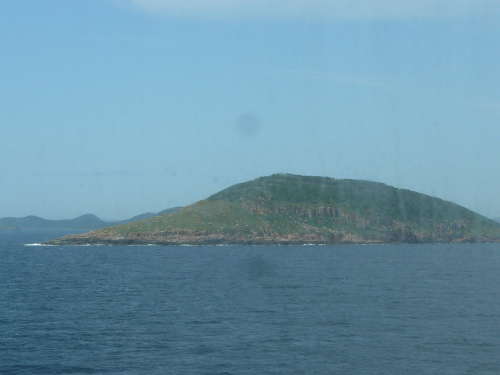 Location Taken: Southern coast of Newfoundland
Location Taken: Southern coast of Newfoundland
Time Taken: July 2012
I bumped into a mention of Alfred Wallace in the book I’m reading. That got me thinking about him and made me recall the Wallace Line, which is nifty enough on its own that I knew I had a blog topic.
If you don’t know, Wallace was one of the inventors of the theory of evolution. While Darwin gets all the fame and infamy, he wasn’t working alone to come up with the complete theory. Wallace was what you’d now call a biogeographer, someone who maps out where different species live (in fact, he’s known as the Father of Biogeography). He found lots of evidence of closely related species that were each on one side of some type of barrier, such as the Amazon River (where Wallace did a lot of his work). This lead him to come up with the concept of natural selection, a major process involved in the evolutionary process. He then sent this idea to Darwin to pass on to a mutual acquaintance, and well, Darwin recognized many of the same ideas that he had been working on himself. It was one of many instances of revolutionary ideas occurring independently to multiple people at around the same time, and in this case lead Wallace and Darwin to collaborate.
…You know, that would be an easy test to see how well someone who is stating a rather strong opinion about evolution (on either side of the topic) actually knows what they’re talking about. Just see if they know who Wallace is. If you’ve studied up, he’s quite important, and if you haven’t, you’ve never heard of the guy.
Anyway, back off that tangent and on to the Wallace Line!
The Wallace Line is a nifty relic of plate tectonics and changing sea levels found in amongst the Indonesian Islands just north of Australia. On one side of the line, you have only Asian animals, and on the other side, only Australian.
Ok, that’s a major oversimplification. Basically, Australia is on a separate tectonic plate than Asia and has been slowly creeping northward for quite some time. There was a very long stretch of time when the Australian continent was completely separated from any other land mass and all the animals that floated along with it took a very different evolutionary path than those found elsewhere. Mainly a highly venomous path, but hey…
Still, there’s a pretty big difference between the monkeys, deer, and elephants on the Asian side and the koalas, kangaroos, and echidnas on the Australian side.
At the height of the Ice Age, the ocean level was much lower, and the large Indonesian islands happened to become part of their closest continents. Sumatra, Java, and Borneo joined with Asia, while New Guinea was part of Australia. However, the ocean is actually rather deep in the area full of tiny, oddly shaped islands between those regions, so that stayed quite wet. This meant that the large islands got fully settled by the continental wildlife while the small ones in the middle didn’t.
One thing to understand about islands. It’s tough to reach them. Most large animals don’t want to swim that far, small creatures can’t manage the swim, and even a lot of birds are hesitant to go over too much flat water. So the islands get populated by whatever’s around that likes to swim or fly that far, or just floated over randomly.
This, of course, means that any area that has a large water gap that’s stuck around for a very long time will have a different mix of animals on each side. And that’s the case with the Wallace Line. It’s really quite simple.
Though technically, the Wallace Line is just one of three biogeographical lines through the Indonesian islands. The Wallace one is furthest west, marking out the zone where all of a sudden the large Asian animals are no longer found on the islands. Then, as you go east, you find the Weber Line and the Lydekker Line, which mark a halfway point between the two fauna types and then the limit of large Australian creatures. In the area between these lines, there’s a mix of the types of animals that can cross the water gaps, a hybrid zone known as the Wallacea Ecozone. I’ll give you one guess where they got that name.
And just think, as the Australian plate keeps moving north, it’ll eventually slam into southeast Asia! Then that whole area will be invaded by kangaroos and fifty varieties of highly deadly creatures! That’ll be fun!
